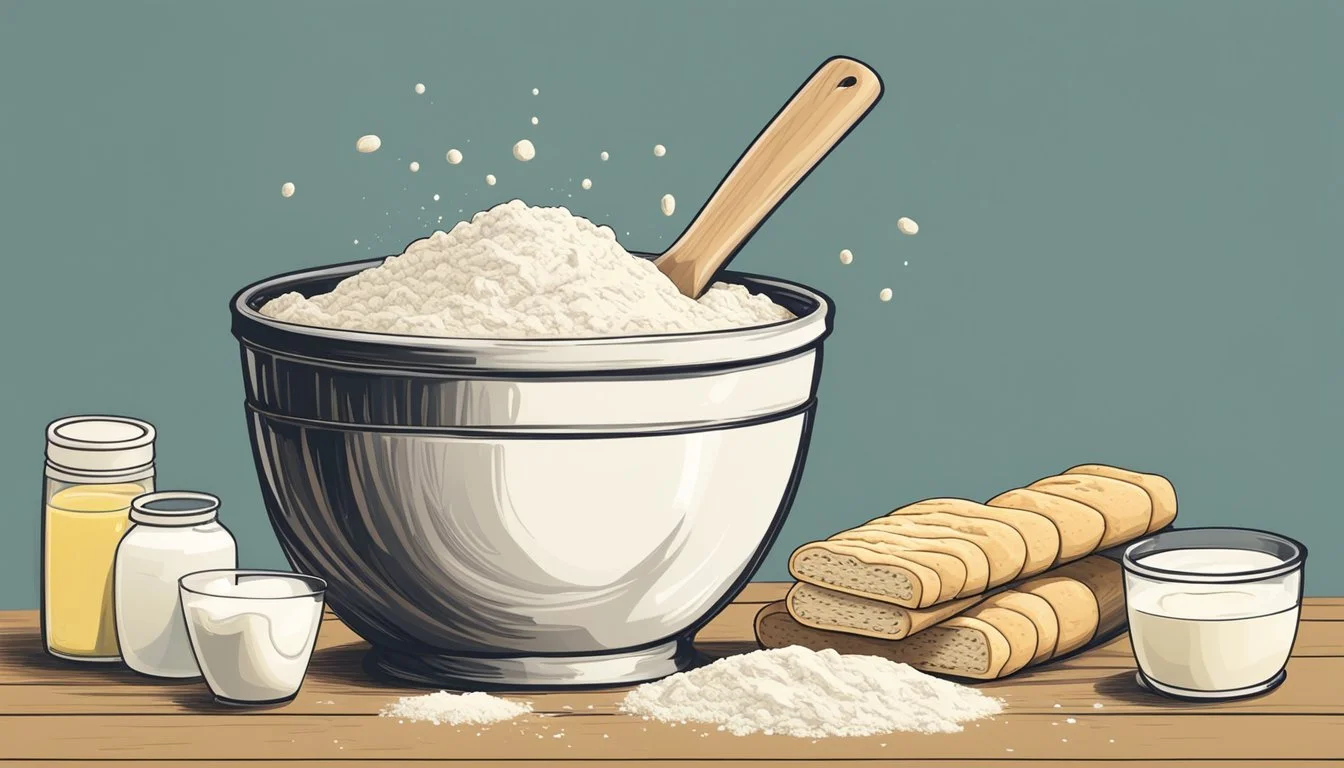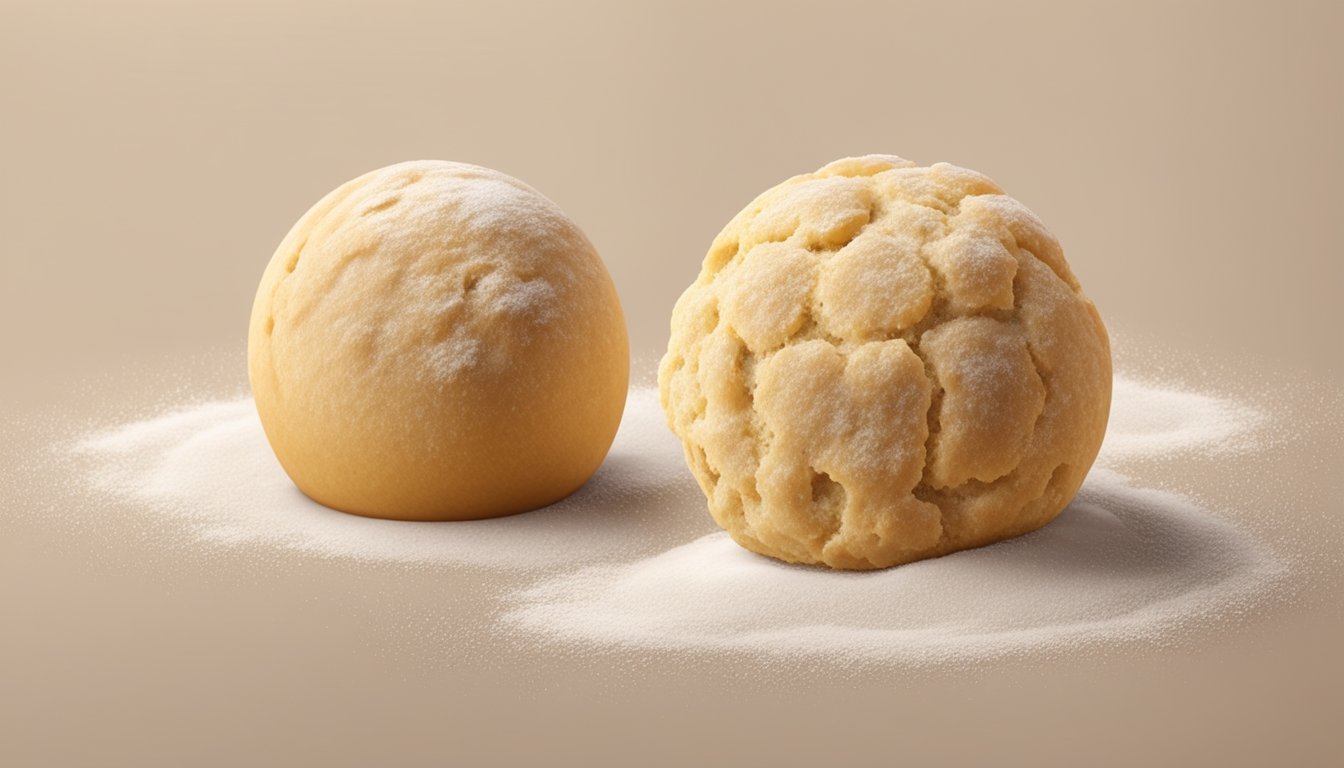Does Biscuit Dough Go Bad?
Shelf Life and Signs of Spoilage
Biscuit dough, like many other perishable foods, does indeed go bad. When stored in the refrigerator, biscuit dough generally lasts up to five to ten days before the risk of spoilage increases. This timeframe can vary depending on the ingredients and storage conditions.
Exposure to moisture and air can accelerate the spoilage process, causing the dough to become stale or develop mold. It's essential to keep the dough properly sealed and stored in the refrigerator to maximize its shelf life. Dough containing milk or eggs may spoil even faster, especially if left at room temperature for an extended period.
Refrigeration is key to preventing spoilage and ensuring the dough remains fresh. Proper storage techniques are essential for anyone looking to bake biscuits that are both safe to eat and delicious.
Understanding Biscuit Dough Composition
Biscuit dough relies on a careful balance of key ingredients to achieve the desired texture and flavor. The interaction between these ingredients also determines the dough's ability to rise and its susceptibility to spoilage.
Key Ingredients and Their Roles
Flour is the base of any biscuit dough. It's typically made from wheat and provides the structure through its protein content, particularly gluten. Self-rising flour is commonly used for convenience, as it contains a leavening agent.
Butter adds both flavor and flakiness. It's incorporated into the dough in small pieces to create layers.
Eggs, when used, contribute richness and moisture, enhancing the dough's texture.
The Science of Dough Rise
Dough rising is a crucial aspect for making tender biscuits. Yeast is not typically used; instead, chemical leaveners like baking powder or baking soda are employed.
These leavening agents produce carbon dioxide gas, which causes the dough to expand. It's essential not to over-mix the dough as it can deactivate the leavening agents, negatively impacting the rise.
Protein from the flour and butter layering technique also plays a role in the dough's expansion during baking.
Moisture and Spoilage Correlation
Moisture content is vital for both the dough’s consistency and its shelf life. Too much moisture can make the dough sticky and difficult to work with.
This excess moisture also creates an environment conducive to mold growth and spoilage. On the other hand, homemade biscuits with adequate moisture are more likely to stay tender.
Proper storage in an airtight container can help prevent moisture absorption from the environment, extending the dough's usability.
Shelf Life and Spoilage Indicators
Biscuit dough, like many other food products, has a finite shelf life. Identifying when it has gone bad involves paying close attention to its appearance, smell, and texture.
Determining Expiration and Quality
Biscuit dough usually comes with an expiration date printed on the packaging. This date helps estimate how long the dough remains at its best quality. Unopened dough stored in a cool, dry place typically lasts longer than opened dough, which is more susceptible to spoilage due to exposure to air and moisture.
Proper storage is essential. Refrigerating or freezing can extend the dough’s shelf life. Dough that includes ingredients like milk or yogurt will spoil faster than dough that does not.
Be cautious of any changes beyond the expiration date. While some dough might remain usable slightly past its date, it is advisable to check for spoilage indicators before use.
Visual and Olfactory Spoilage Signs
Mold growth is a primary indicator that biscuit dough has gone bad. Check the surface for any unusual spots or fuzzy growths. Discoloration is another warning sign; dough should maintain a consistent color.
A change in texture, such as becoming excessively dry or sticky, also signals spoilage. Similarly, a foul smell suggests the dough is no longer safe to use. Fresh biscuit dough typically has a neutral or slightly yeasty smell.
If any of these spoilage signs are present, it is best to discard the dough. Using spoiled dough can result in poor baking results and potential health risks.
Proper Storage Techniques
To ensure biscuit dough remains fresh and safe to use, proper storage is essential. This includes refrigerating the dough for short-term use, freezing it for longer storage, and using suitable containers to maintain quality.
Refrigerating Dough for Freshness
Refrigerating biscuit dough can keep it fresh for short durations. After preparing the dough, wrap it tightly in plastic wrap to prevent exposure to air. This helps maintain moisture and flavor.
The dough should then be placed in the refrigerator, where it can stay fresh for up to 2 days. This method works well for doughs that will be used soon, preserving their texture and taste.
If the dough develops a sour smell or unusual color, it has likely gone bad and should be discarded.
Best Practices for Freezing Dough
For long-term storage, freezing biscuit dough is effective. First, mold the dough into desired shapes or portion sizes. Place these on a cookie sheet lined with parchment paper and freeze until solid.
Once frozen, transfer the dough pieces to a freezer bag or airtight container. Label the container with the date of freezing and use it within 3 months for best quality.
When ready to use, thaw the dough in the refrigerator overnight. This gradual thawing helps maintain the dough's integrity and taste.
Container Choices for Extending Shelf Life
Choosing the right container can significantly impact the shelf life of biscuit dough. Airtight containers or freezer bags are ideal for maintaining freshness. These containers prevent air and moisture from deteriorating the dough.
A plastic bag with a zip seal is also suitable, especially if it is designed for freezer storage. For an added layer of protection, the dough can be wrapped in plastic wrap before placing it in the container.
Labeling containers with dates helps track storage time, ensuring the dough is used within its optimal period for the best results. Properly storing biscuit dough not only extends its shelf life but also ensures the quality of the final baked product.
Defrosting and Handling Preparations
Properly defrosting and handling biscuit dough is crucial for maintaining its texture, flavor, and rise. This section covers the best thawing methods and tips for preventing contamination to ensure your biscuits remain fresh and safe to eat.
Thawing Methods and Timelines
Defrosting biscuit dough can be done in several ways. For best results, move the frozen dough to the refrigerator the night before you plan to bake it. This gradual thawing helps retain moisture and texture. It typically takes around 12-24 hours for the dough to thaw in the fridge.
Alternatively, if time is limited, place the wrapped dough on a baking sheet lined with parchment paper at room temperature. This method usually takes a few hours but should be monitored closely to avoid the growth of bacteria.
If you need a quicker solution, using the defrost setting on a microwave is possible, but it may affect the dough's texture and rise. Always ensure the dough is thoroughly defrosted before baking to achieve the best results.
Preventing Contamination During Handling
Cleanliness is key when handling thawed biscuit dough. Begin by washing your hands thoroughly to prevent the transfer of bacteria. Use a clean surface and tools, like a rolling pin and baking sheet, to avoid contamination.
Avoid leaving the dough at room temperature for extended periods. Dough left out for over an hour can become a breeding ground for bacteria, compromising both safety and quality. If the dough will not be used immediately, keep it refrigerated until you are ready to proceed.
Separate utensils for raw and baked items are recommended to prevent cross-contamination. Always ensure that the workstation and tools are sanitized before and after handling the dough for optimal food safety.
By following these precautions, you can ensure that your defrosted biscuit dough is both safe to eat and delicious.
Recognizing Safe Use and Consumption
Understanding the signs of unsafe biscuit dough and the difference between "best before" and "use-by" dates can help ensure flavorful and safe treats. Specific indicators can help determine when it is time to discard the dough to avoid food poisoning.
Signs of Unsafe Biscuit Dough
Spoiled biscuit dough can exhibit several signs that indicate it is no longer safe to use. Visual cues such as mold growth or discoloration are clear indicators of spoilage. The presence of an off-putting or sour odor also signals that the dough might be contaminated.
Texture changes can also occur; dough that feels overly sticky or dry may be unsafe. If the package has been punctured or not sealed properly, it increases the risk of contamination. Always trust your senses—when in doubt, it’s safer to discard questionable dough to avoid the risk of food poisoning.
Best Before vs. Use-By Dates
Best before dates suggest the time range during which the product maintains its optimal quality. Dough past this date isn't necessarily unsafe but might experience diminished taste or texture. Many biscuit doughs can be used slightly past this date without posing a health risk but might not be as delightful.
Use-by dates, on the other hand, are stricter because they relate to safety. Consuming biscuit dough past this date can lead to foodborne illnesses. Manufacturers test these dates to ensure that the product is safe up to the specified time, so strictly adhering to use-by dates is crucial for health. Always refer to these dates to determine whether to keep or discard your dough.
Making the Most of Leftover Biscuit Dough
Leftover biscuit dough can be creatively repurposed to prevent waste and enhance meals. Proper storage ensures the dough remains fresh and usable for future culinary endeavors.
Creative Uses for Unused Dough
Leftover biscuit dough can be transformed into a variety of delicious dishes. Croutons can be made by baking small dough pieces until crisp, providing a crunchy addition to salads and soups. For breakfast, the dough can be shaped into cinnamon rolls; simply add butter, sugar, and cinnamon before baking.
Pull-apart bread is another versatile option. Roll the dough into balls, coat with melted butter, and layer with cheese or herbs. Bake until golden for a savory treat. Lastly, use the dough for dumplings in stews or soups. Cut into small pieces and drop them into simmering liquids, allowing them to cook until fluffy.
Storage Tips for Leftovers
To maintain the freshness of leftover biscuit dough, store it properly. Wrap the dough tightly in plastic wrap or place it in an airtight container, then refrigerate for up to three days. For longer storage, freeze the dough. Roll it into a log, wrap in plastic wrap, and then in aluminum foil. Freeze for up to three months.
When ready to use frozen dough, thaw it in the refrigerator overnight. Avoid thawing at room temperature, as this can affect the dough's texture. For best results, revitalize the dough by lightly kneading it before use. These practices ensure the dough remains optimal for future cooking.
Pizza Dough vs. Biscuit Dough
While both pizza dough and biscuit dough are used to create delicious baked goods, they have distinct characteristics in terms of storage, flavor, and versatility in recipes.
Storage Similarities and Differences
Pizza dough often contains yeast, requiring careful storage to maintain its rising potential. Usually, it's stored in the fridge, wrapped tightly to prevent drying out. Short-term storage involves refrigerating for 24-48 hours, but it can be frozen for up to 3 months.
Biscuit dough typically includes fat, such as butter or lard, making it more sensitive to temperature changes. It is commonly refrigerated and should be used within a few days to avoid becoming stale. Freezing can extend its life up to a month but can affect the texture.
Keeping both types of dough fresh involves avoiding exposure to air and moisture. Proper wrapping and container use ensure that they maintain their quality.
Flavor and Texture Considerations
Pizza dough is made with flour, water, yeast, and salt, intended to create a chewy and crisp texture once baked. The gluten development in pizza dough is crucial for its elasticity and structure, allowing it to be stretched thin without tearing.
Biscuit dough includes flour, salt, and fat, resulting in a tender and flaky texture. The fat content, whether butter or lard, ensures the dough remains tender. Unlike pizza dough, minimal gluten development is desired to keep the biscuits soft and tender.
Flavor-wise, pizza dough acts as a neutral base for various toppings, while biscuit dough’s buttery richness stands out on its own, often complementing sweet and savory fillings.
Cross-Utilization in Recipes
Though primarily used differently, biscuit dough can serve as a substitute for pizza dough in some recipes. Using it creates a flaky and buttery crust, adding a unique twist to traditional pizza.
Pizza dough can also be adapted for certain biscuit recipes, especially in savory applications. However, the texture may be chewier and less tender compared to traditional biscuit dough.
Cross-utilization allows for creativity but requires adjustments in baking techniques and temperature. For instance, pizza dough requires a hot oven to achieve a crisp crust, whereas biscuit dough needs careful handling to maintain its flaky texture.
These differences and similarities in storage, flavor, and usage highlight the unique properties of each dough type while allowing for culinary experimentation.
Advanced Tips for Biscuit Dough Care
Proper storage and handling are essential to maintaining the quality and freshness of biscuit dough. These tips will help ensure the dough stays at its best, even after freezing.
Enhancing Flavors Post-Freezing
Once biscuit dough has been frozen and thawed, there are techniques to enhance its flavors. Adding grated cheese or seasoned herbs can elevate a simple dough. Ensure that any additions are mixed evenly.
Bacteria growth can be minimized by ensuring that thawed dough is not left unrefrigerated. If stored in an airtight container, the dough should maintain its quality for up to three months in the freezer.
Canned biscuits benefit from being separated before freezing, as this prevents them from sticking together. Upon thawing, allowing the dough to rest briefly before baking can improve texture. Adjust baking times slightly to accommodate any changes from freezing.









